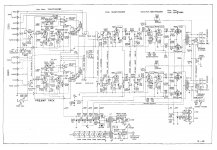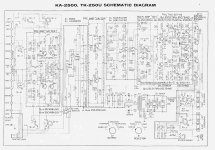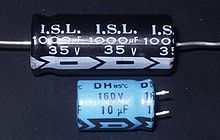I thought the same way, but in reality it works.Dear Alex.
Demian is right about the impedance's. 1G Ohm or more has higher resistance than dust in normal humidity. Even if the process of design a PCB board, resistance in that order would require GND guards.
Up two a few megaohm is okay. Noise would be an big issue. Not noise from the jfet but thermal noise from the resistor it self.
Distortion due to voltage modulated capacitance on the input of the JFET would be the next concern.
BR
Sonny
The resistance of 100 pF capacitor of feedback on 20 Hz is
79577471 Ohm = 79 MOhm.
It makes the any impact of 1 GOhm resistor near zero to AC.
PCB resistance or dust conductivity has nothing here to compete with 1 GOhm resitor - it is here just to balance the DC drift and DC offset. It can be larger or smaller - for DC offset it does not matter. But it can not compete in AC with 100 pF capacitor. Thats it.
As for noise - yes there can be issues, for shure. But this is a headphones amplifier just to show the core design concept. This is not for phono. For phono first stage - use 100MOhm...1 GOhm and larger feedback mica capacitors, up to 1000 pF, no problem, but the sound quality will be slightly worse, with small "solid-state" coloration.
Last edited:
You do not undertand power supply capacitors too.Simplest calculation shows up that energy in power supply capacitors of tube amplifiers - due to higher voltage (energy ~ V^2....) - is 20-100 times higher than in transistor amplifiers (much lower voltage).
When comparing tube and Solid State: V^2 is larger while C is smaller. Energy C x V^2 is the same.
That was a mistake in the 60s when SS replaced tubes in audio.
BTW We are waiting for a proof that makes sense about your alleged "skin effect" in audio.
C'mon. This is school grade math.You do not undertand power supply capacitors too.
When comparing tube and Solid State: V^2 is larger while C is smaller. Energy C x V^2 is the same.
That was a mistake in the 60s when SS replaced tubes in audio.
BTW We are waiting for a proof that makes sense about your alleged "skin effect" in audio.
Even the typical cap 100 uF at 300V has 10 times bigger energy than typical 2000uF at 20V.
Last edited:
C'mon. This is school grade math.
Quite so, elementary. I did a spreadsheet a while back which clearly showed that higher voltage caps give higher energy density on the PCB than caps below 63V. Nowadays thanks to LED lighting we have 10mm dia caps with upwards of 4J/cm^2. Can anyone find a cap at or below 63V giving over 4J/cm^2? It would need to be 2200uF/63V but under 10mm dia.
Yeap. Rupert Neve uses 90 volts (I beleive 45+45) in his recent analogue mixing consoles. He is 92 now.Quite so, elementary. I did a spreadsheet a while back which clearly showed that higher voltage caps give higher energy density on the PCB than caps below 63V. Nowadays thanks to LED lighting we have 10mm dia caps with upwards of 4J/cm^2. Can anyone find a cap at or below 63V giving over 4J/cm^2? It would need to be 2200uF/63V but under 10mm dia.
Thank You, Rupert for Pink Floyd and ABBA sound.
Wrong.C'mon. This is school grade math.
Even the typical cap 100 uF at 300V has 10 times bigger energy than typical 2000uF at 20V.
Use 100µF at 300V and 22000µF at 20V. That is typical.
I did a quick Taobao search, found 100uF/400V and compared its size with 22000uF/25V. The latter was bigger even though it stores fewer Joules.
Sizes ? Link ?I did a quick Taobao search, found 100uF/400V and compared its size with 22000uF/25V. The latter was bigger even though it stores fewer Joules.
Interesting: What is diameter and lenght, so we can know the volume ?
Typical sizes can be misleading.
Typical sizes can be misleading.
Those numbers were dia*height in mm. I'll let you do the math. If you think my numbers are biassed, Mouser might be a good place to run your own search.
Incidentally if laying out a PCB and height wasn't an issue, the 100uF/400V can be had in a 13mm dia can, 55mm high.
Incidentally if laying out a PCB and height wasn't an issue, the 100uF/400V can be had in a 13mm dia can, 55mm high.
Where is your logic?Wrong.
Use 100µF at 300V and 22000µF at 20V. That is typical.
As we speak about 100uF 300V and what is TYPICAL (in tube-vs-transistor) - we speak about consumer-grade audio.
Instead, high-end-grade capacitors of 22000 uF 100V appeared in expensive high-end Krell KSA50/ KSA100 amplifiers in 1983.
I am sure there were NO capacitors 22000 uF 20V in consumer-grade audio before 1981-1982.
At that time there were no consumer-grade tube amplifiers.
Sony Global - Sony Design - History - 1970s
Actually the tube substitution was made around 1973-1976. I own Trio/Kenwood unique receiver with TUBE schematic, typical tube interior and BJT transistors replacing the tubes, dated around 1975-1976. Stunning tube-like sound.
You are trying to compare 1970 consumer-grade tube with 1983 high-end solid-state.
This is absolutely illogical, unless your real task other than finding the truth.
The point is - "the most engineers" did not recognize the obvious difference in sound and did not make school-grade math in 1970-1980.
The truth is in physics. The volume of a cap is in proportion of the energy it can store.Where is your logic?
As we speak about 100uF 300V and what is TYPICAL (in tube-vs-transistor) - we speak about consumer-grade audio.
Instead, high-end-grade capacitors of 22000 uF 100V appeared in expensive high-end Krell KSA50/ KSA100 amplifiers in 1983.
I am sure there were NO capacitors 22000 uF 20V in consumer-grade audio before 1981-1982.
At that time there were no consumer-grade tube amplifiers.
Sony Global - Sony Design - History - 1970s
Actually the tube substitution was made around 1973-1976. I own Trio/Kenwood unique receiver with TUBE schematic, typical tube interior and BJT transistors replacing the tubes, dated around 1975-1976. Stunning tube-like sound.
You are trying to compare 1970 consumer-grade tube with 1983 high-end solid-state.
This is absolutely illogical, unless your real task other than finding the truth.
The point is - "the most engineers" did not recognize the obvious difference in sound and did not make school-grade math in 1970-1980.
Bipolar transistors, replacing tubes is 1966 for engineers up to date at that time.
Last edited:
‘Dark Side of the Moon’ Recording Console Heads to Auction – Rolling StoneYeap. Rupert Neve uses 90 volts (I beleive 45+45) in his recent analogue mixing consoles. He is 92 now.
Thank You, Rupert for Pink Floyd ..... sound.
EMI TG12345 - Wikipedia
Polar Studios - WikipediaYeap. Rupert Neve uses 90 volts (I beleive 45+45) in his recent analogue mixing consoles. He is 92 now.
Thank You, Rupert for..... and ABBA sound.
Harrison Audio Consoles - Wikipedia
Solid State Logic 4056 E-Series Console | Reverb
'The centrepiece of the studio was a Harrison mixing console, which was modified by technician Leif Mases to give it a unique sound that in some respects resembled a Neve. ABBA's 1981 album The Visitors marked a turning point for Polar, as it was recorded on the studio's new 3M digital recorder - thus becoming one of the first digital mainstream pop records.[3]"
Polar's recording facility consisted of two different sections, one that utilized analog tape machines and one that implemented the cutting-edge digital equipment of the day.
Studio A featured a Solid State Logic 4056 Series mixing board, coupled with any combination of a Studer A-820 24-track, Studer A-827 24-track, or Otari DTR-900 MK II 32-track tape machines.[9] Studio A featured four separate isolated rooms, each with varying acoustics.
Last edited:
The truth is in physics. The volume of a cap is in proportion of the energy it can store.
Got a link in support of that claim?
Got a link in support of that claim?
1) C = S / ( d x e ) Where S is the surface of the plates, d the distance between plates, e the dielectric constant.
2) Breakdown voltage is in proportion of d.
Using 1) and 2) you end up at: The volume of a cap is in proportion of the energy it can store.
Last edited:
You have been misled by too-fast-web-search. Groups I mentioned above were using VARIOUS mixing consoles and techniques. ABBA recorded their FIRST albums not in Polar studio you mentioned, but in small studio "Metronome Studio" with Rupert Neve custom-made "Red Camel" console.
Neve Console - which model is this one? - Gearslutz
Actually with moving to newer Polar Studio the sound quality of ABBA was degraded and the finish of ABBA was clearly visible.
As to Pink Floyd: I did not say that DSOM was recorded on Neve console.
Neve consoles were FLAGSHIPS for other consoles manufactures for decades, and the etalons of good sound for musicians all over the globe.
How about Alan Parsons speaks:
"In this video, he discusses his relationship with Rupert Neve and his designs over the decades, and how he chose the 5088 as the centerpiece of his newly-built studio in southern California."
YouTube
Nope, we dont want simply "energy". We want FILTERING of 100 Hz (120 in USA) signal from rectifier.The truth is in physics. The volume of a cap is in proportion of the energy it can store.
Bipolar transistors, replacing tubes is 1966 for engineers up to date at that time.
The standalone capacitor IS NOT A FILTER.
(if the circuit consumes current, but who needs circuit that does not consume energy?)
Do you understand this simple phrase? Tube amplifiers had INDUCTORS and RESISTORS in power supply circuit. The RC or LC combination is a filter. Why in universe the audio-engineers expelled RC or LC circuitry from power supply - I dont know.
The point is:
even if the energy of tube caps was only 2-3 times higher then in transistors amplifier at that time - 1966-1973, the filtering ability of tube amplifiers was much higher - due to RC and LC circuits.
You can make you calc by yourself:
Trio 1966 tube recevier W46K:
50uFx360V+50uFx335V+40uFx310V and resistors 1k, 33k, 6.8k etc.
Trio W-46K Restoration | twiddlingmyknobs

Trio 1973 transistor receiver:
2200uFx50V + 1000uFx25 V and one resistor 1k:
Doz' Blog: Trio (Kenwood) KA-2500 amplifier repair & renovations.

Last edited:
- Home
- Source & Line
- Analog Line Level
- Discrete Opamp Open Design
